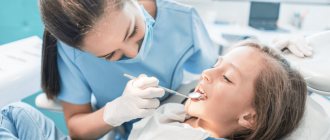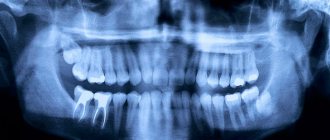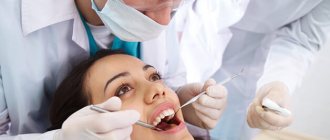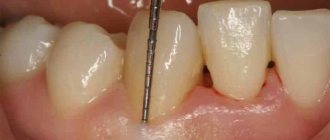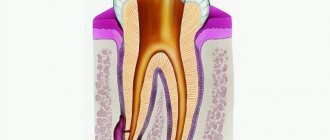Pericoronitis, or a total inflammatory process of the gums caused by infection in the oral cavity. Most often it occurs at the time of tooth eruption, especially with the growth of wisdom teeth. The process is accompanied by severe swelling of the gums, severe pain, especially when opening the mouth, as well as an unpleasant odor and unusual taste from the mouth. In addition, pericoronitis is accompanied by a state of general weakness, less often by a rise in temperature to a low-grade level. Some people also note discomfort in the digestive tract (diarrhea, among others).
Causes of pericoronitis
As the tooth erupts, it rests on the mucous membrane. He does not always immediately overcome this barrier. A tooth can remain under the gum from 4 weeks to 6 months or more, gradually lifting and injuring the gum. This leads to the fact that the gums cease to protect the tissues from pathogenic bacteria and small food particles; they easily penetrate under it and provoke an inflammatory reaction.
The inability to perform hygiene under the hood is the main mechanism of pericoronitis. But other factors can increase the risk of inflammation or worsen the situation:
- anatomical features of the structure of bone tissue and gums - thickened periosteum or gums, lack of space in the jaw;
- violations of the rules of oral hygiene - in this case, it is easier for bacteria to begin to actively multiply;
- trauma - damage to periodontal tissues by solid food particles, excessive brushing with bristles during cleaning;
- chronic diseases of the oral cavity - erosions and ulcers, stomatitis, gingivitis, caries, pulpitis, periodontitis, including near the erupting tooth;
- dystopic or impacted tooth, eruption at an angle, impossibility of complete eruption.
More often, pericoronitis is observed in the area of erupting eights or wisdom teeth. This is due to the fact that they appear in adulthood, when the dentition is formed and the jaw has stopped growing. At the end of the dentition there is simply no room left for a large tooth, and therefore the figure eight grows at an angle or is partially hidden by the gum. If wisdom teeth begin to erupt before the age of 20, the process is usually easy. At older ages, the process is more often complicated by pericoronitis.
Ask a Question
Varieties
Depending on the severity of the process, its location and the degree of complexity of the disease, the following types of pericoronitis are distinguished:
- catarrhal;
- ulcerative;
- purulent isolated subacute;
- retromolar;
- spicy.
Let's take a closer look at each type of disease.
Catarrhal
Catarrhal pericoronitis occurs most often, as it is the initial stage of the development of the disease. If you consult a doctor for help in a timely manner, you can avoid the occurrence of more complex and advanced forms of the disease.
The catarrhal form manifests itself with almost all the main symptoms in a mild form, with the exception of the absence of purulent discharge from under the gingival hood. If treatment is started in a timely manner, the inflammatory process quickly stops, and all the main symptoms disappear during the treatment process.
Ulcerative
The cause of ulcerative pericoronitis is infection of the inflamed gums by fusosprirochaetes. The main symptom of this type of disease is the presence of a necrotic ulcerative rim along the edges of the gums. If you remove the plaque covering the gum, its bleeding increases. In case of ulcerative pericoronitis, surgical treatment is contraindicated; this type of disease is treated exclusively with conservative methods.
Purulent isolated subacute
Purulent isolated subacute pericoronitis is a chronic form of the disease. This form is characterized by severe constant pain in the area of the erupting tooth, which intensifies during chewing or swallowing food. Often accompanied by an increase in temperature to 38°. Regional lymph nodes are greatly enlarged; due to pain and swelling of the inflamed tissues of the gums, cheeks, soft palate and palatoglossal arch, the patient cannot open his mouth. If you press on the gingival hood, purulent exudate is squeezed out from under it. X-ray examination can detect bone resorption in the area of the wisdom tooth. All this indicates a chronic course of the disease.
Retromolar periostitis
If, during pericoronitis, the outflow of purulent exudate from under the gingival hood is disrupted, and the purulent infection spreads to the periosteum of the retromolar fossa, then an abscess is formed in this place, and the process itself is called retromolar periostitis. The symptoms of this disease are very similar to the symptoms of purulent pericoronitis, but are much more pronounced, the pain becomes unbearable. Body temperature can rise to 38.5°, the patient's general condition deteriorates sharply.
The doctor forcibly opens the patient's mouth for a visual examination, as a result of which strong and extensive inflammatory changes in the soft tissues surrounding the erupting tooth are established. Upon palpation, the doctor detects an infiltrate in the retromolar region, the presence of which allows one to diagnose retromolar periostitis.
Treatment of this disease should be carried out by an experienced dentist, since improper treatment may result in the formation of a fistula tract.
Spicy
Acute pericoronitis is an inflammatory process associated with the eruption of wisdom teeth. It is characterized by all of the above symptoms, and without proper treatment it quickly becomes chronic. If it lasts for a long time, it can be complicated by the occurrence of purulent periostitis. It should be noted that acute pericoronitis is the most common - approximately 60-70% of all cases of eruption of lower third molars are accompanied by this disease.
Symptoms of pericoronitis
Pericoronitis of the tooth begins with pain in the gum area, which intensifies with pressure. You can usually notice discomfort when chewing or brushing your teeth. The gum area becomes swollen and red, and subsequently an unpleasant odor appears from the mouth.
In the absence of timely medical assistance, other manifestations also occur:
- spread of pain radiating to the ear, temple;
- difficulty swallowing, sore throat;
- speech difficulties;
- limitation of mouth opening due to swelling of the peripharyngeal area;
- enlarged lymph nodes;
- low-grade fever;
- swelling of the cheek due to inflammation.
A person experiences difficulty chewing food and may suffer from a general deterioration in health and headaches.
Symptoms may subside after some time, which means that the disease has entered a chronic stage. Purulent complications may also occur, and if a passage opens in the gum to remove purulent contents, the acute pain goes away. However, the inflammatory process persists.
Types and forms of the disease
There are acute and chronic pericoronitis. Acute, in turn, is classified into the following types:
- Catarrhal. The disease begins with swelling and redness of the gums, pain, and itching. This is the simplest form of the disease.
- Ulcerative. It is characterized by the formation of ulcerations covered with a white coating on the mucous membrane of the gums, necrotization of tissue along the edges of the ulcer.
- Purulent. In the area of inflammation, serous and subsequently purulent contents are released. It is characterized by throbbing pain, general intoxication of the body, and bad breath.
Chronic pericoronitis is a consequence of an untreated acute period. With it, the symptoms become less pronounced, but serous or purulent contents continue to form. It can lead to the formation of a pathological passage through which the contents are discharged into the oral cavity. Chronic pericoronitis is characterized by periodic exacerbations; they can be provoked by tooth movement and other unfavorable factors, a general decrease in the body's defenses.
In the chronic form, lymphadenitis is often observed. The mucous membrane, even in the absence of unpleasant symptoms, is swollen and has a reddish tint. Despite the absence of serious difficulties when speaking, chewing, or opening the mouth, it is important to get help from a dentist, since the risk of complications is quite high, and the disease may not go away on its own.
Diagnosis of pericoronitis
Manifestations of acute pericoronitis may resemble pulpitis and periodontitis. But even an untrained person can distinguish these diseases from each other. Thus, with acute pulpitis, throbbing pain does not interfere with opening the mouth, and the gums often remain calm, without swelling and redness.
With periodontitis, swelling and redness of the gums are common symptoms. But periodontitis develops under a fully erupted tooth and is most often a consequence of advanced caries. With pericoronaritis, the tooth has not fully erupted.
A dentist can make an accurate diagnosis. Radiography is mandatory - a targeted image will help to accurately assess the condition of the tissues, the position of the erupting tooth in the jaw, the extent of the spread of the inflammatory process, and also exclude diseases with similar symptoms.
What is pericoronitis
Pericoronitis is a process during which the gum tissue becomes inflamed. A similar complication occurs when the tooth is difficult to cut and takes a long time. Pericoronitis is usually noted in relation to the wisdom teeth, which are located below. And here it is important to start treating the disease in time to avoid the acute stage.
Because there is no room for such teeth, they erupt incorrectly. When the gums are injured over a long period, inflammation begins. There are cases when the tooth has not fully erupted and is almost invisible. Pericoronitis can also develop here.
What happens if pericoronitis is not treated?
It is important to understand that pericoronitis will not go away on its own. Even if after 4-5 days the symptoms subside, this does not mean that the inflammatory process is over. From time to time the disease will go into the acute stage and cause a lot of inconvenience. In addition, pericoronitis can cause serious complications.
- Periostitis, or flux, as well as osteomyelitis. The spread of the inflammatory process to the periosteum and bone tissue can be explained by a decrease in local and general protective forces and other factors. Such complications will require serious medical intervention.
- Mobility of adjacent teeth.
- Cellulitis, abscess, lymphadenitis.
- Formation of fistula tract, cysts. The appearance of ulcerative stomatitis.
- Damage to nearby tissues, otitis, pharyngitis and other inflammatory complications in the area of ENT organs.
- Sepsis.
Therefore, treatment of pericoronitis is mandatory, regardless of the area in which the inflammation has spread. Lack of timely medical care can lead to inflammatory consequences and even loss of healthy adjacent teeth.
Prevention and prognosis
There are no specific preventive measures to prevent the development of pericoronitis. The only preventive measure is regular visits to the dentist - which will make it possible to diagnose the disease at the initial stage of development, as well as cure dental diseases that provoke the occurrence of an inflammatory process in the gum tissue.
The prognosis of pericoronitis in the vast majority of situations is favorable - timely therapy begins to achieve complete recovery, and complications develop quite rarely. However, patients should not forget about the tendency of the disease to relapse and become chronic.
Surgical methods of treatment
Treatment of pericoronitis is almost always surgical. And if we talk about molars and premolars, dentists choose the tactic of excision of the gingival hood. But treatment in the area of eights is almost always performed by removing wisdom teeth, and further we will explain why.
Excision of the gingival hood opens access to the growing tooth; this measure allows not only to remove excess inflamed tissue and thoroughly rinse the area, but also to help the tooth erupt completely and take its correct place in the dentition. This method has several conditions or indications:
- integrity of the crown and root system of the erupting tooth;
- correct location of the tooth in the bone tissue of the jaw;
- availability of sufficient space for complete tooth eruption in the row.
That is, this approach is used in all cases where the gums are the only obstacle to normal tooth eruption. If a unit of the dentition is not very healthy, for example, caries is observed, the integrity of the crown is compromised, or there are diseases of the root system, then the decision is made individually. If it is advisable to preserve the tooth, the doctor will also perform an intervention and take measures to eliminate the pathology.
Impacted and dystopic teeth, as well as situations in which complete tooth eruption will inevitably lead to malocclusion or displacement of adjacent teeth are indications for a different type of surgical treatment. The doctor may suggest tooth extraction, and in cases of disease above the “eight” level, this is almost always the only option to solve the problem.
The fact is that wisdom teeth do not bear a functional load, very often erupt at an angle, interfere with neighboring teeth and increase the risk of complications, including bite defects. Therefore, it is considered appropriate to remove the “eight” and further measures to eliminate inflammation in the soft tissues.
The only exceptions are cases when the “eight” could potentially be used as a support for a prosthesis or be important in planned orthodontic treatment.
In general, the following cases and features are indications for removal of both the hood and the tooth:
- excision of the hood has already been performed previously, but the inflammation has not gone away and/or has intensified, there is no effect from the treatment;
- the tooth does not have enough space in the dentition;
- impacted, dystopic tooth, the preservation of which jeopardizes the health of neighboring teeth and the oral cavity;
- the gingival hood grows over the erupting tooth again (this rarely happens);
- the tooth is affected by caries/destroyed, its treatment and preservation are impractical.
Since it requires the removal of a tooth that has not yet fully erupted, the procedure is considered a complex extraction. Most often, it requires preliminary dissection of the gums and extraction of the tooth from deep-lying tissues. Therefore, in many cases, sutures will be required on the gums, which will speed up tissue healing.
Surgical treatment of pericoronitis is performed under local anesthesia, so the procedure will not cause discomfort. An obligatory step is washing the mucous membrane with antiseptic solutions.
Removal of tissue hanging over the tooth can be done with conventional instruments or a laser.
Diet for the treatment of pericoronitis
Proper nutrition is part of the treatment of pericoronitis; compliance with certain rules is required not only after surgery to excise the hood, but also after removal of a wisdom tooth. To speed up the healing of the mucous membrane, it is recommended:
- Exclude rough foods from the menu, for example, crackers, chips, nuts.
- Raw vegetables and fruits need to be washed well so that there is no soil or other particles left on them that can become a source of infection.
- Do not consume spicy, sour and salty foods, carbonated drinks, or alcohol.
- The temperature of food and drinks should be around 37°C; hot and cold food is prohibited.
- It is better to chop all food before consumption, especially raw carrots, apples, and cucumbers. You need to try to introduce more soft and liquid dishes into the menu.
It is also recommended to follow these rules:
- After the operation is completed, you must refrain from eating for 2-3 hours.
- While eating, do not open your mouth wide to prevent the sutures from coming apart.
- Do not chew on the side of the surgical procedure.
Otherwise, there are no restrictions; after a few days, provided the mucous membrane has successfully healed, you can return to your normal diet.
Laser treatment
Laser excision of the hood provides better results. The main advantages include:
- lower risk of inflammatory complications, including secondary wound infection;
- coagulating effect of the laser - no risk of bleeding;
- short recovery period;
- reduction of pain after intervention;
- no need to additionally treat intervention areas with turundas and antiseptics.
There are few contraindications for laser intervention, one of them being cancer.
